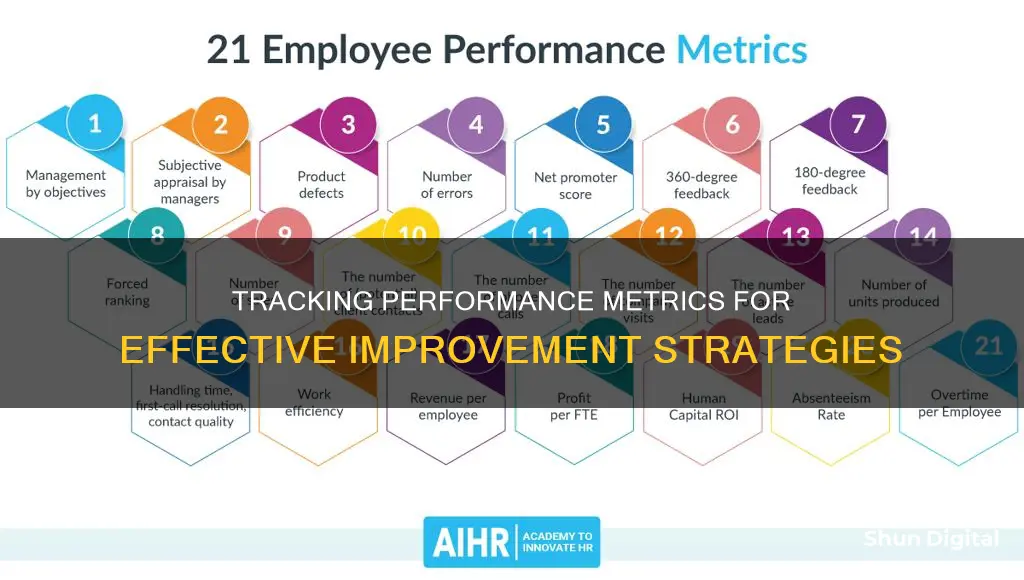
Monitoring employee performance is an increasingly important aspect of maintaining a competitive edge for businesses. It helps organisations identify areas where employees and processes can be improved and plays a major role in driving business success. There are several methods and tools that can be used to monitor and improve performance, including regular check-ins and one-on-one meetings, performance management software, employee monitoring software, peer reviews, self-reported surveys, and incentives. Additionally, it is important to define success criteria, collect and analyse data, communicate and report results, review and adjust interventions, and implement best practices.
| Characteristics | Values |
|---|---|
| Key Performance Indicators (KPIs) | KPIs are quantifiable metrics that objectively measure performance against predetermined benchmarks. |
| Performance Metrics Dashboards | Dashboards provide real-time visibility into team and individual performance, enabling proactive decision-making and fostering collaboration. |
| Management by Objectives (MBO) | MBO involves setting measurable objectives that align with organisational goals and individual growth aspirations. |
| Qualitative Insights and Feedback | Incorporating qualitative feedback with quantitative metrics offers a holistic view of team member performance and promotes a culture of continuous improvement. |
| Attendance and Completion Metrics | Monitoring attendance and completion metrics helps gauge reliability, dedication, and task completion efficiency. |
| Tracking Initiative | Tracking employee initiative provides insights into an employee's dedication, skill set, and commitment to continuous improvement. |
| Numeric Rating Scales | Numeric ratings assign a point value to each performance measurement, helping to prioritise the steps of the performance management plan. |
| Self-Evaluations | Self-evaluations involve creating objective criteria to determine how close an organisation is to reaching its performance measurements. |
| Peer Reviews | Peer reviews provide a forum for direct feedback from colleagues, offering a variety of perspectives on the current state of performance. |
| Duties and Functions Checklist | A clear and authoritative checklist of duties and functions ensures accountability and transparency, enhancing performance by creating clear expectations. |
| Performance Management Cohorts | Joining a cohort of similar organisations provides a realistic baseline and offers opportunities for collaboration, innovation, and problem-solving. |
What You'll Learn

Set SMART goals
Setting SMART goals is a crucial aspect of performance improvement. SMART is a helpful acronym that ensures your objectives are clearly defined and attainable within a certain timeframe. SMART goals are:
Specific
A specific goal answers important questions such as what needs to be accomplished, who is responsible, and what steps need to be taken to achieve it. For instance, a goal could be to "increase the number of monthly users of Techfirm's mobile app by optimising our app-store listing and creating targeted social media campaigns."
Measurable
Making your goals quantifiable makes it easier to track progress. For example, you could aim to "increase the number of monthly users of the mobile app by 1,000" instead of just aiming for vague "positive growth".
Achievable
Goals should be realistic and attainable with hard work, focus, and dedication. For instance, if you have a small team, creating ad campaigns for four social media platforms might be too much, so you could scale back to three platforms.
Relevant
Your goals should align with the wider organisational objectives and your job. For example, increasing mobile app usage might be a goal as it can increase customer loyalty and, ultimately, profitability.
Time-Bound
SMART goals should have clear timelines and deadlines. When will the team start and finish their tasks? When will they implement their strategies? An example of a time-bound goal is to "grow the number of monthly users of the mobile app by 1,000 within Q1 of 2022."
By setting SMART goals, you can improve your chances of success and ensure your goals are well-defined and realistic.
Televisions as Monitors: Easy Setup Guide for Beginners
You may want to see also

Track key performance indicators
Tracking key performance indicators (KPIs) is a crucial aspect of monitoring and improving performance. KPIs are quantifiable metrics that provide insights into an individual or team's progress, efficiency, quality, and customer satisfaction. They serve as a compass, guiding you toward your defined success criteria. Here are some strategies for tracking KPIs effectively:
Define your KPIs:
Firstly, you need to identify the specific KPIs that align with your goals and objectives. Examples of common KPIs include cycle time, defect rate, cost reduction, customer feedback, and quality of work.
Collect and analyse data:
Regularly gather relevant data to track your defined KPIs. Utilise various tools such as surveys, interviews, observations, checklists, charts, and dashboards to collect both quantitative and qualitative data. Compare the data to pre-improvement benchmarks to identify strengths, weaknesses, gaps, and opportunities for improvement.
Track quality of work:
Assess the consistency of quality across team members. Obtain qualitative feedback from customers and peers through 360-degree feedback to gain insights into their satisfaction and promote transparency.
Measure productivity:
Evaluate employee output over a given period, considering both the quantity and quality of their work. Measure the percentage of tasks completed on time versus late to identify areas where improvements can be made.
Evaluate goals achieved:
Assess the percentage of goals achieved versus those that were not. This analysis can initiate necessary discussions to help individuals find practical solutions to enhance their performance.
Utilise monitoring software:
Leverage technology by using monitoring software to automate data collection and gain accurate insights into team performance. This can include tracking website activity, time spent on tasks, and analysing data related to tasks completed during the day.
Regular check-ins:
Schedule regular one-on-one meetings and check-ins with team members to discuss progress, address concerns, and provide guidance. These meetings help maintain transparency, foster trust, and ensure individuals are on track with their goals.
Recognise and reward:
Motivate your team by recognising and rewarding their achievements. This can be done through appreciation, sharing praise from clients, or offering incentives such as gift cards or paid trips.
By effectively tracking and analysing KPIs, you can make data-driven decisions, identify areas for improvement, and enhance overall performance.
Refurbished Monitors: Worth Buying or Wasteful?
You may want to see also

Leverage monitoring software
Monitoring software is an essential tool for businesses aiming to improve their performance and achieve optimal results. By leveraging technology, organisations can automate tasks, streamline processes, and make data-driven decisions. Here are some key ways in which monitoring software can be leveraged to improve performance:
Data Accuracy and Efficiency:
Monitoring software provides data accuracy and efficiency in performance tracking. It enables organisations to collect, analyse, and visualise large volumes of data efficiently. This technology automates data collection, reducing manual effort and potential errors. The software also facilitates data visualisation through charts, graphs, and dashboards, making it easier to identify trends and patterns.
Key Performance Indicators (KPIs):
KPIs are vital metrics for monitoring and improving performance. Monitoring software helps define and track KPIs such as cycle time, defect rate, cost reduction, and customer feedback. By setting clear KPIs, organisations can measure progress, efficiency, quality, and customer satisfaction. This data-driven approach enables businesses to identify areas of improvement and make informed decisions.
Automated Data Collection:
Monitoring software automates the collection of quantitative and qualitative data from various sources, including surveys, interviews, observations, and feedback. This ensures a comprehensive view of performance by capturing data from different stakeholders, such as customers, employees, and partners. The software streamlines data gathering, saving time and providing a continuous flow of information for analysis.
Real-Time Insights and Alerts:
Leveraging monitoring software provides real-time insights and alerts on critical performance indicators. For example, in hardware monitoring, software can track temperature, voltage, fan speeds, and other hardware parameters. This enables proactive issue resolution, ensuring system stability and optimal performance. Real-time data also facilitates timely interventions and strategic adjustments.
Customisable Dashboards and Visualisations:
Monitoring software often includes customisable dashboards and visualisation tools. These features allow users to tailor the presentation of data to their specific needs. Visualisations, such as graphs and charts, make complex data more accessible and interpretable. Customisable dashboards enable different teams and departments to create views that align with their unique objectives and KPIs.
Integration and Compatibility:
Monitoring software with strong integration capabilities can seamlessly connect with existing systems and tools used by organisations. This ensures compatibility with different operating systems, hardware, and third-party applications. Smooth integration enhances data flow between systems, improves data accuracy, and enables a comprehensive view of performance across various platforms and sources.
By leveraging monitoring software, organisations can automate performance tracking, gain data accuracy, and make informed decisions. The software provides efficient data collection, real-time insights, customisable visualisations, and seamless integration. These capabilities empower businesses to identify areas of improvement, take timely actions, and drive continuous growth.
Ford Focus: Blind Spot Monitoring Feature Explained
You may want to see also

Regular check-ins
When implementing regular check-ins, it is important to create a safe and open environment where employees feel comfortable discussing their progress and any challenges they may be facing. This can be achieved by scheduling one-on-one meetings at regular intervals, such as weekly or bi-weekly, to provide a more casual format for these discussions. During these meetings, team leaders or managers can discuss progress, address concerns, and provide guidance and feedback.
In addition to individual check-ins, regular team meetings can also be beneficial. These meetings allow everyone to discuss their goals and identify areas where they can improve collectively. It also provides an opportunity to solve any challenges that the team may be facing and ensures that everyone is aligned and working towards the same objectives.
To make the most of regular check-ins, it is important to set clear and specific goals that are measurable, achievable, relevant, and time-bound (SMART goals). These goals should be established collaboratively between the employee and the manager and should be reviewed and adjusted as needed. Regular check-ins provide an opportunity to track progress towards these goals and make any necessary adjustments.
Furthermore, regular check-ins can also be used to celebrate successes and recognise employees for their achievements. This helps to boost morale and motivate employees to continue performing at a high level. Overall, regular check-ins are a crucial aspect of performance monitoring and improvement, as they provide a forum for open communication, feedback, and collaboration, ultimately driving business success.
Blind Spot Monitor: Does Toyota's System Beep?
You may want to see also

Recognise and reward
Recognising and rewarding your team members is a vital step in helping them achieve their performance goals. After all, 46% of the workforce has left their jobs because they felt underappreciated.
Recognition and rewards elevate performance and business outcomes. Companies that have a recognition program drive an 11.1% increase in average workforce performance.
- Express appreciation for their contributions and hard work. This can be done publicly (e.g., company meetings) or privately (e.g., one-on-one meetings or handwritten cards). Ask your team members what type of recognition they prefer.
- Share praise from clients/customers to show that their efforts and outcomes are making impactful contributions.
- Offer rewards that your team members prefer. For example, a survey indicated that 44% of team members prefer gift cards, while 41% prefer a paid trip.
- Create incentives to participate. Some employees may be hesitant to join performance monitoring programs for fear of micromanagement. Emphasise that performance monitoring will help them get rewards in the form of raises, promotions, or bonuses.
Finding Folders: Mediamonkey's Monitoring Magic
You may want to see also







